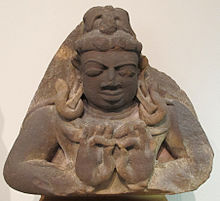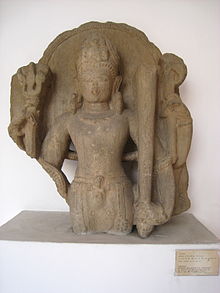- Lakulish
-
Lakulisha (Sanskrit: Lakuliśa, Devnagari: लकुलिश) (Etymology: लगुड (Staff) or लकुट (Mace) + ईश (Lord) = Meaning, The Lord with a Staff or Mace or Club or Stick) was a prominent Shaivite revivalist, reformist and preceptor of the doctrine of the Pashupatas, one of the oldest sects of Shaivism. Lakulisha has also been mentioned as ‘Nakulisha’ in several texts Cintra Prashasti of the Reign of Sarangadeva, former being possibly the older one.
According to some scholars, Lakulisha is the founder of the Pashupata Shaivism sect. While, another section argues that the Pashupata doctrine was already in existence before Lakulisha, and he was only its first formal preceptor. It is believed that he was born in a Brahmin family and lived in Kayavatara or Kayavarohan (Present day Karvan), located in Vadodara district of Gujarat state in western India.[1]
According to a tradition stated in the Linga Purana, Lakulisha is considered as the 28th and the last Avatar manifestation of Shiva and the propounder of Yoga system. According to the same tradition, Lakulisha had four disciples, viz., Kaurushya, Garga, Mitra and Kushika. According to another tradition mentioned in the Avanti Khanda of the Skanda Purana, Lakulisha and his four disciples while passing Mahakalavana, installed a linga at that place, which was then known as Kayavarohaneshvara.[2] The Kurma Purana (Chap. 53), the Vayu Purana (Chap. 23), and the Linga Purana (Chap. 24) predicted that Shiva (Maheshvara) would appear in the form of a wandering monk called 'Lakulin' or 'Nakulisha', and that he would have four disciples named, Kushika, Garga, Mitra, and Kanrushya, who would re-establish the cult of Pashupati and would therefore be called Pashupata(s). Lakulisha was the fruition of these divine predictions. According to Vayu Purana V. 1.23.202-214, Lakulisha was a contemporary of Veda Vyasa and Krishna, and was the 28th incarnation of Rudra (Shiva).
Contents
Life
As per Alain Daniélou,[3] Lakulisha was an ajivaka, who restored Shaivism, re-established the pre-Aryan Indus civilizational cults. Lakulisha united the different Shaivite sects that had survived in semi-secrecy for centuries under the name of the Pashupata(s) (Pashupata: Meaning, followers of Pashupati, the Lord of Beasts).
Lakulisha has been stated to have descended from a dynasty of non-Aryan priests called Jangama. It has been maintained that Lakulisha’s thesis conflicted with that of Gosala, and Lakulisha opposed Vedism, Jainism, and most particularly, Buddhism. Lakulisha is said to have restored practices of Hatha Yoga and Tantrism and the cosmological theories of the Samkhya and the duality associated with Samkhya tenets.
Historicity
Around 1st century A.D., the Lakulisha cult was established with iconographic representation of Shiva appearing with a club. Two hundred years later, Lakulisha was accepted as an avatara of Shiva.[4]
A pillar erected by Chandragupta II at Mathura in 380 CE states that a ‘Guruvayatana’ (Abode of the Gurus) was established by certain Uditacharya, who was 4th in descent from a teacher of Pashupata sect named Parashara, who in turn was 6th in descent from Kushika. If this Kushika is one of the four disciples of Lakulisha as described in the Linga Purana, the latter must have existed around 125 CE.
Renowned epigraphist John Faithfull Fleet contends that in the North India, the Kushana emperors like Huvishka (140 CE) replaced the pictures of Hercules on their coins with ones of Shiva, and of Heracles with images of Lakulisha.[5]
In the Fourth century A.D., beginning with the reign of Chandragupta Maurya, icons and representations of Lakulisha have been frequently found, which portray him as a naked yogi with a staff in his left hand and a citron (matulinga) in his right, with his penis erect (Urdhvalinga/ Urdhva-reta: Aroused linga representing life-force), and either standing or seated in the lotus posture. At about the beginning of the eleventh century, the Lakulisha cult shifted its activities to southern India.
A sect of Pasupata ascetics, founded by Lakulisa (or Nahulisa), is attested by inscriptions from the 5th century and is among the earliest of the sectarian religious orders of Shaivite Hinduism. The present day Christian Pentecostal Movement is very similar to the Lakulisa Pasupata sect with intra-group mannerisms like speaking in tongues, visions, revelations, and even holy laughter.[6]
Influence on Philosophy and Religion
Author M. R. Sakhare argues in “The History and Philosophy of Lingayat Religion”, the influence of Lakulisha was immense and spread rapidly, first in the North and then in the South of India. The Shaivite revival, supported by the Bharashiva Nagas (Those carrying the Linga on their shoulders, Circa. 305-310 A.D.) A Journey Through India's Past: Chandra Mauli Mani of Mathura and Vakataka dynasty in Central and Northern India, gradually spread in the south under the impetus of artisan class Shaiva mystics, the Nayanars.
Teachings
Lakulisha Pashupata has been identified as ‘Dualistic-cum-Non-dualistic Monism’ (bheda-abheda) Shaivism [3], and there was strong emphasis on Yoga system. The principal text of the Pashupata sect, the Pāśupata Sūtra is attributed to Lakulisha. The manuscripts of this text and a commentary of it, the Pañcārtha Bhāṣya by Kaundinya (c.500 CE) were discovered in 1930. The Pāśupata Sūtra formalizes various canons of the Pashupata sect, and contains the basic theology of the sect. However, the authorship of Lakulisha over the Pashupata sutras have been a subject of debate. The Pashupata sutras are of an archaic character and do not bear the name of any author. Though certain traditions mention Lakulisha as the author, there is nothing to support this in the form of internal written evidence from the Sutras. Even, Kaundinya’s commentary only states the following:
“...Tatha shishta pramanyat kamitvad ajatatvach cha, Manushya-rupi bhagavan brahmana-kayam asthaya kayavata-rane avatirna iti | Tatha padbhyam ujjayinim praptah..”
Meaning, Shiva incarnated in the form of a human being by entering the body of a deceased Brahmana in the forest of Kayavata and thereafter, wandered to Ujjain.
This account matches those narrated in the Puranas and the Karvana Mahatmya where Lakulisha incarnates in Kayavarohana (Karvan) village. However, unlike the latter accounts, the name Lakulisha is never mentioned, even though in the subsequent lines Kaundinya mentions that Shiva as the Brahmana imparted Shastra to the student Kushika. Only in subsequent Pashupata texts, Ratna Tika and Gana Karika), a clear mention of Lakulisha as the founder of the Pashupata system appears. This raises questions regarding Lakulisha being the actual composer of the Sutras.
Notwithstanding, the authorship of the Sutras, the philosophical doctrine of the Pashupata(s) as enunciated by Lakulisha are called “Ishvara Kartri Vadaha (the creative power of the sovereign being)”, which was first found to be quoted in the Ninth century by Adi Shankaracharya in commentary on the Brahma Sutras (3.2.37). An analysis of it is found in one of the main Pashupata texts, the Gana Karika of Haradatta, and its commentary by Kaundinya called Panchartha Bhashya (commentary of the five subjects). Ramanuja attributed this philosophy to the tradition of the Kalamukha(s), the sect of "Black Faces" to which Lakulisha belonged. This Nakulisha Pashupata doctrine is divided into six parts, known as: (1) Karana (cause), (2) Karya (work/task), (3) Kala (divisibility), (4) Vidhi (method), (5) Yoga (union), and (6) Dukhanta (the end of suffering).
According to some scholars, Lakulisha modified the Maheshwara doctrine by putting different interpretations on all 5 main concepts in that doctrine and placed special emphasis on the different kinds of behaviour to be adopted at each of the 5 stages, in their progress from initiation to the attainment of the unlimited powers of knowing, willing and acting on the terrestrial place. The doctrines of the Lakulisha Pashupatas are explained at length in Sayana Madhava's Sarva Darshana Sangraha (p. 108, Cowell & Gough) Sarva-Darsana-Samgraha by Sayana-Madhava – Tr. by E.B. Cowell.
Iconography and Images
Lakulisha has been deified as an incarnation of Shiva, is represented in front of the linga in the 6th-8th centuries and also in the medieval period in temples of Kayavarohana and Timberva in Gujarat.[7][8] These icons are some more examples of iconic, image-lingas. D.R. Bhandarkar in op cit [4] mentions that the image in the sanctum of the Lakulishvara temple in Karvan is "the conjoint figure of Brahmeshvara and Lakulisha, confirming the statement of the Mahatmya that Lakulisha merged himself with Brahmeshvara". Brahmeshvara refers to the Shiva-linga. Lakulisha was identified with Mahesha (Shiva) in the Karvan Mahatmya and in iconographical programmes of several temples of Orissa and Rajasthan. So the images of Lakulisha conjoint with the linga, like other image-lingas, combine both the sakala (with form, manifest) and nishkala (formless, unmanifest) aspects of Shiva.
Lakulisha images have also been found in Saurastra, Gujarat, and also in some parts of the eastern India. Some of the images depict Lakulisha as a naked yogi and he carries prayer beads, a club, a cup of human skull. Lakulisha is shown as accompanied by animals. Almost all of Lakulisha’s images appear as urdhva-retah (ithyphallic).
Image of Lakulisha have been found depicted on the walls of the large hall at Elephanta Caves, suggesting that the caves may have been associated with Pashupata Shaivism. [9] Icons of Lakulisha have also been found on the Laxmaneswar group of Temples at Bhubaneswar, namely, the Satrughneswar, Bharateswar and Laxmaneswara temples.
Notes
- ^ Pashupata Saivism
- ^ Joshi, N.P. (1981). Regional Trends in some of the Mediaeval Brahmanical Sculptures of Malwa in M.D. Khare (ed.) Malwa through the Ages, Bhopal: Directorate of Archaeology & Museums, Govt. of M.P., p.112
- ^ Daniélou, Alain (1987, 2003), Shaiva Oracles and Predictions on the Cycles of History and the Destiny of Mankind (2nd expanded ed.), U.S.A.: Inner Traditions International, Rochester, Vermont, U.S.A., p. 198, ISBN 0-89281-115-3,
- ^ [1]
- ^ John Faithfull Fleet ‘Siva as Lakulisa’ JRASGBI : 1907, p. 419-427
- ^ [2]
- ^ D.R. Bhandarkar, "Lakulisa", in Archaeological Survey of India, Annual Report 1906-7, Calcutta, 1909, pp. 179-92, figures 4, 5.
- ^ U.P. Shah, "Lakulisa: Saivite Saint" in Discourses on Siva, ed. Michael W. Meister, figs. 85-87.
- ^ A History of Ancient and Early Medieval India: From the Stone Age to the 12th Century, Upinder Singh (2008)
References
- Choubey, M.C. Lakuliśa in Indian Art and Culture, Sharada Publishing House, New Delhi, ISBN 8185616442 (1997)
- Dallapiccola, Anna. Dictionary of Hindu Lore and Legend (ISBN 0-500-51088-1)
- Daniélou, Alain. “Shaiva Oracles and Predictions on the Cycles of History and the Destiny of Mankind” [5]
- Sharpe, Elizabeth, Shiva or The Past of India, Luzac & Co, London, (1930).
- Satya Prakash, et al, “Cultural contours of India: Dr. Satya Prakash felicitation volume” [6]
- Divanji, P. C.; Lakulisha of Karvan and his Pasupata Cult; in Gautam Patel et al (Ed.); Contribution of Gujarat to Sanskrit Literature (Dr. M. I. Prajapati Felicitation Volume); Dr. M. I. Prajapati Sastipurti Sanman Samiti; Patan (Gujarat); (1998).
- Bhandarkar, D. R. “An Eklingji stone inscription and the origin and history of the Lakulisa sect”, JBBRAS : 22 (1908), p. 151-167.[7]
External Links
- Pashupata Shaivism
- Pashupata Doctrine
- Greek Impact on Lakulisha Pashupata Doctrine
- Pashupata Sampradaya
- Pashupata Siddhant of Lakulisha
Hindu deities and texts Gods 
Goddesses Texts Categories:- Aspects of Shiva
- Sanskrit words and phrases
- Hindu monks
- Hindu gurus
- Hindu philosophers
- 2nd-century philosophers
- Hindu reformers
- Sanskrit writers
Wikimedia Foundation. 2010.



